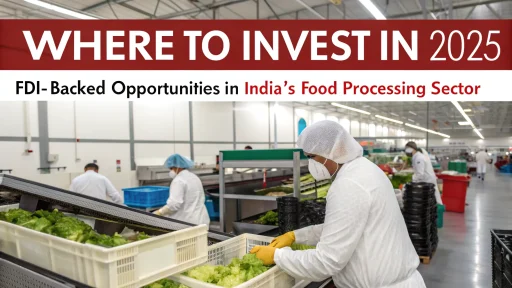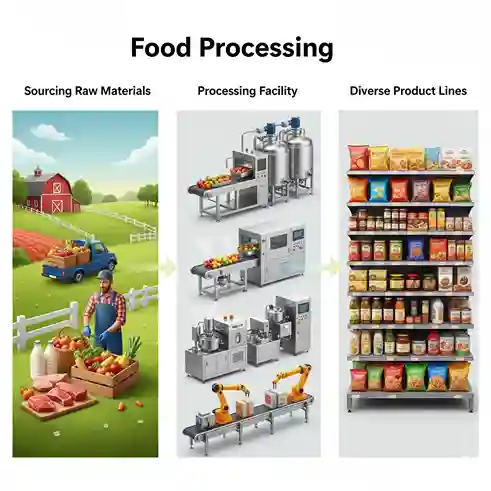India’s food processing sector is on the verge of transformation. Foreign investors are increasingly viewing India as a prime gateway for food infrastructure, processing units, and technology. This sector now sees unprecedented levels of Foreign Direct Investment (FDI, p. 10). Supported by government policies, increasing consumer demand, and aggressive marketing, the India food processing sector is booming and is poised for smart and scalable investments.
According to the Ministry of Food Processing Industries (MoFPI) Annual Report 2023–24, the FDI inflow in food processing industries from April 2014 to March 2024 was USD 6.80 billion, showcasing strong investor sentiment (MoFPI, p. 15). In the following sections, I will discuss which subsectors and states are most profitable for investment in 2025 along with FDI trends, relevant policies, and real market data from preceding years.
India’s Food Economy: Key Growth Metrics
India still ranks among the three global leaders for the production of milk, cereals, fruits, and vegetables and spices. In addition to this, the country has a large agricultural base along with an exponentially growing middle class. This guarantees India’s food sector long-term sustained growth.
| Indicator | Value (2022–23) |
| Food Processing GVA | ₹1.92 lakh crore |
| Share in Manufacturing GVA | 7.66% |
| Total Agri-Food Exports | USD 46.43 Billion |
| Registered Employment in Food Processing | 20.68 lakh |
| Unincorporated Sector Employment | 51.11 lakh |
| Share of Processed Food in Exports | 23.4% |
(Source: MoFPI Annual Report 2023–24)
Related: PMFME Scheme: A Game-Changer for Micro Food Enterprises in India
Why Global Investors Are Eyeing India’s Food Sector
1. 100% FDI Under Automatic Route
India offers one of the few simplest processes for foreign companies as the country allows 100% FDI in the food processing sector under the automatic route.
2. Export Opportunity
In 2022, India only had a share of 2.55% in global agri-food exports, showing significant room for growth. India’s strategic logistics hubs and cold chain development are making Indian processed food competitive on a global scale.
3. Policy Push
From the PM Kisan SAMPADA Yojana to the PLI schemes, MoFPI is actively offering incentives, grants, and support for exports to attract private investment.
FDI Inflows in Food Processing (2014–2024)
| Year | FDI Inflows (USD Million) |
| 2014–15 | 516.72 |
| 2015–16 | 505.02 |
| 2016–17 | 727.22 |
| 2017–18 | 904.90 |
| 2018–19 | 628.24 |
| 2019–20 | 904.70 |
| 2020–21 | 393.41 |
| 2021–22 | 709.72 |
| 2022–23 | 895.34 |
| 2023–24 | 608.31 |
(Source: Department for Promotion of Industry and Internal Trade – MoFPI Annual Report)
Investment Opportunities to Target in 2025: Key Growth Sub-Sectors
1. Ready-to-Eat (RTE) and Convenience Foods
Changes in food consumption habits has boosted the growth of this sector along with the export market Gulf countries, Europe, and the US.
- Top States: Maharashtra, Gujarat, Tamil Nadu
- FDI Focus: Technology for microwave-safe packaging, aseptic processing
2. Cold Chain Infrastructure
This segment which includes cold storage, refrigerated vans, and packhouses is crucial for the overall food security and export potential of India.
- Top States: Maharashtra, Uttar Pradesh, Karnataka
- MoFPI Support: Grants up to ₹10 crore per project
3. Processing Units
India is the largest producer of milk in the world, but only 35% of the product is processed. Modernizing supply chain and packaging systems with suitable FDI will greatly benefit this sector.
- Leading Regions: Punjab, Haryana, Uttar Pradesh
- Investment Opportunities: UHT milk, ice cream, cheese, and ghee
4. Organic and Herbal Foods
India is the leading global producer of turmeric, ginger, and herbal botanicals. There is increasing need for organic foods with verifiable supply chains.
- Leading Regions: Kerala, Andhra Pradesh, Rajasthan
- Targeted Exports: Ayurvedic food supplements, spice oils, oleoresins
5. Marine and Meat Processing
Combined marine and meat exports were nearly USD 10 billion in 2023–24. With foreign investment, India can move up the value chain in frozen, ready-to-cook and halal-certified products.
- Top States: Andhra Pradesh, Tamil Nadu, Kerala, West Bengal
- FDI Opportunity: Frozen shrimp, seafood processing plants, and halal meat packaging
FDI Destination States: Who’s Winning?
| State | Key Sectors | FDI Potential (2025 Outlook) |
| Maharashtra | RTE foods, cold chain, fruits | Excellent – world-class logistics |
| Gujarat | Beverages, oilseeds, and dairy products | High – food clusters and SEZs |
| Andhra Pradesh | Marine products, mangoes, and spices | Very High – export-oriented |
| Punjab | Dairy, wheat, and frozen vegetables | High – dairy tech & supply chains |
| Tamil Nadu | RTE foods, seafood, and bakery products | High – skilled workforce |
| Uttar Pradesh | Dairy, mango, and flour production | Emerging – huge raw base |
What the Government Is Doing to Attract FDI
Under MoFPI’s Guidance:
- Nivesh Bandhu Investor Portal for project matchmaking and policy insights.
- Mega Food Parks Scheme: 41 parks sanctioned with common infrastructure.
- PLI Scheme for Food Sector: Offers incentives for manufacturing and branding.
- World Food India and other events generated MoUs worth ₹33,129 crore, helping global companies partner with Indian firms.
Related: Top 10 Government Schemes for Food Processing Startups in India
What Entrepreneurs Can Build with FDI Support Investment Type & Business Model Examples
| Investment Type | Business Model Example |
| Greenfield Processing Unit | New fruit juice plant in Maharashtra |
| Joint Venture | Partner with Indian firm for dairy export unit |
| Contract Manufacturing | Set up seafood packaging for Gulf exports |
| Infrastructure Development | Develop multi-temperature cold chain in Punjab |
Compliance & Certifications for Export
FDI-backed businesses must meet global certifications such as:
- FSSAI (India)
- HACCP / ISO 22000
- BRC (British Retail Consortium)
- HALAL (for meat and confectionery)
- ORGANIC (EU, USDA)
NPCS: Your Knowledge Partner for Food Processing Ventures
At Niir Project Consultancy Services (NPCS), we empower entrepreneurs and global investors by preparing:
- Market Survey cum Detailed Techno Economic Feasibility Reports
- Comprehensive guides on manufacturing processes, raw material sourcing, plant layout, financial modeling and more
- Tailored reports that evaluate the technical and financial feasibility of establishing new businesses
NPCS provides actionable guidance whether you are considering a bakery line in Gujarat or a cold chain hub in Uttar Pradesh, aligned to your investment objectives.
For more information watch our related videos on food processing
Challenges and How to Fix Them
| Problems | Solutions |
| Difficulties in Buying Land | Utilize Industrial Clusters or Special Economic Zones (SEZs) |
| Logistics Bottlenecks | Build Gati Shakti-enabled Corridors |
| Certification Complexity | Employ export compliance consultants |
| Policy Variability by State | Utilize Nivesh Bandhu or NPCS publications for direction |
The Road Ahead: India’s FDI–Food Processing Vision
Focused on one of the largest food processing markets in the world, India’s food processing industry is projected to reach USD 472 billion by 2030, growing at a higher compound annual growth rate (CAGR) of 12% during this period. Along with increasing retail spending, the demand for healthy, traceable, and premium foods presents ample opportunity for investment.
India’s competitive advantage includes:
- Abundant raw materials
- A young and educated workforce
- Middle class population with rising aspirations for food
- Shift in government policies such as “Make in India” and “Export from India”
Final Thoughts: Why 2025 is the Year for Action
There exists abundant investment opportunities in India’s food processing sector including ready-to-eat (RTE) meals, dairy, marine processing, and herbal nutrition. With favorable policies and ROI, competitive innovation is ready and waiting at the frontier to be unleashed.
Seize the moment: 2025 stands at the forefront for domestic entrepreneurs and international investors seeking immense growth in India’s food processing sector.







